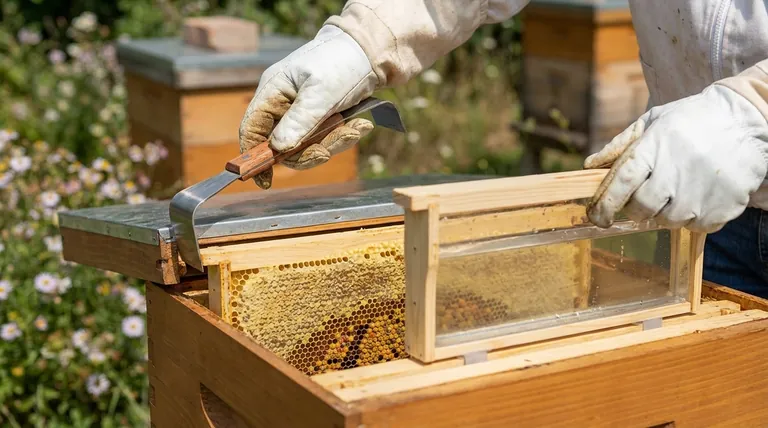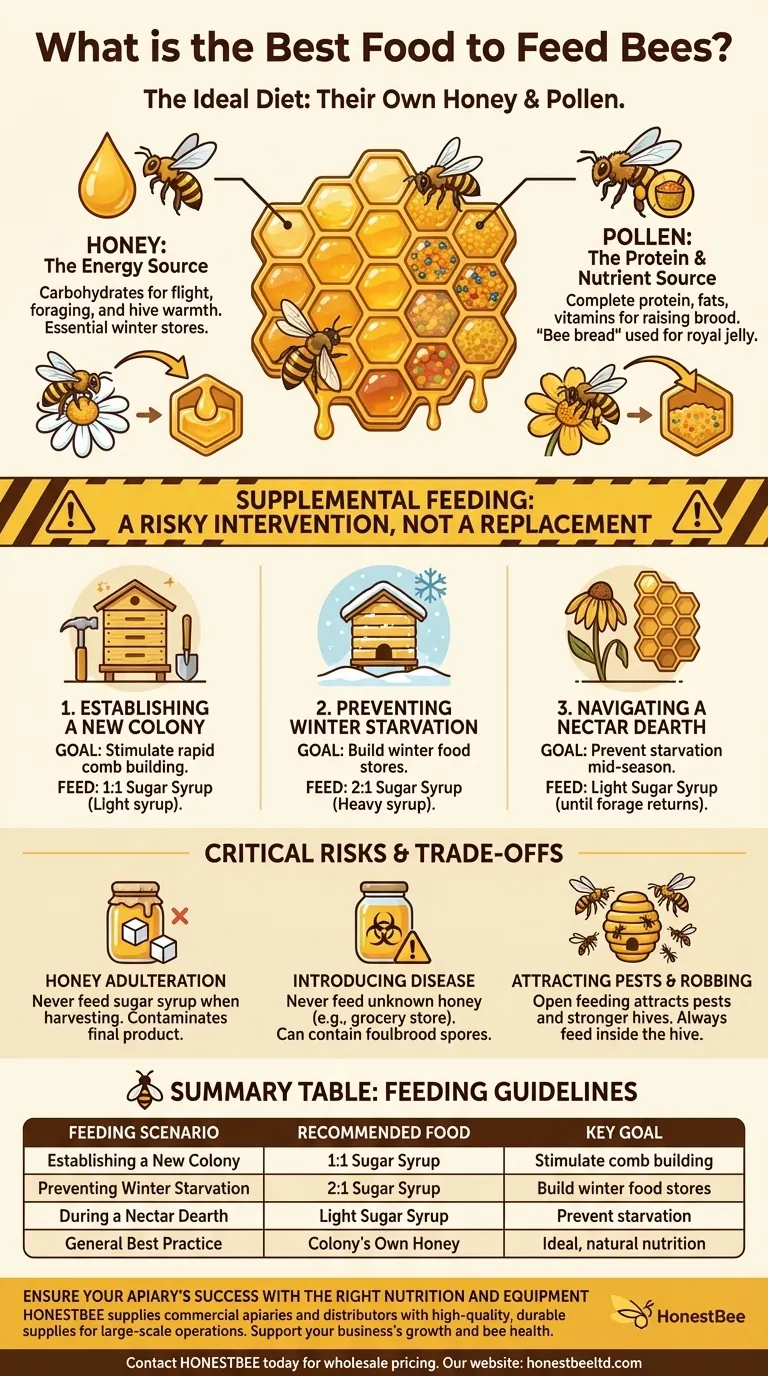Without question, the best food for honey bees is the honey and pollen they collect and produce themselves. This natural diet provides the perfect balance of carbohydrates, proteins, fats, and micronutrients essential for their health and longevity. Supplemental feeding is an intervention for specific situations, not a replacement for the bees' own stores.
A hive's own honey is the ideal food source. When beekeepers must provide supplemental feed, the goal is always to support the colony's survival without contaminating the honey meant for harvest or introducing disease.

The Ideal Diet: What Bees Eat Naturally
Honey: The Energy Source
Honey is the primary source of carbohydrates for bees. They process plant nectar into honey, which fuels their daily activities, including flight, foraging, and maintaining the crucial temperature of the hive cluster during winter.
A colony's ability to survive the winter is directly tied to its honey reserves. This is why beekeepers, especially in colder climates, must ensure hives have ample stores before the season ends.
Pollen: The Protein and Nutrient Source
Pollen is often called "bee bread" and serves as the bees' complete protein source. It is also packed with essential fats, vitamins, and minerals.
This nutrient-dense food is absolutely critical for raising new bees (brood). Nurse bees consume large amounts of pollen to produce the royal jelly needed to feed the queen and developing larvae.
Why Supplemental Feeding Becomes Necessary
While a bee's own honey is best, there are critical times when a beekeeper must intervene to ensure the colony's survival or successful establishment.
Establishing a New Colony
Newly installed packages or nucs have a monumental task: they must build comb, raise brood, and gather food all at once. Providing a light sugar syrup gives them the immediate energy boost needed to rapidly build out their new home.
Preventing Winter Starvation
If a colony enters winter with insufficient honey stores, it will starve. In late fall, a beekeeper may feed a heavy sugar syrup that the bees can process and store as a substitute for honey to survive the cold months.
Navigating a Nectar Dearth
A "dearth" is a period when no nectar-producing flowers are in bloom, often occurring in mid-summer. During a dearth, a strong hive can quickly consume its stores. Light feeding can prevent starvation until natural forage becomes available again.
Understanding the Trade-offs and Risks
Supplemental feeding is a powerful tool, but it comes with significant risks if not managed correctly. Your goal is to support, not harm.
Risk: Honey Adulteration
This is the most critical rule of feeding. Never feed sugar syrup when you expect to harvest honey. If bees store sugar syrup in the honey supers, it contaminates the final product. This is not honey, and selling it as such is unethical and often illegal.
Risk: Introducing Disease
Never feed bees honey from an unknown source, especially grocery store honey. Commercial honey can contain the spores of devastating diseases like American Foulbrood, which can quickly kill your entire colony. Only feed back a colony's own honey or honey from a trusted, disease-free apiary.
Risk: Attracting Pests and Robbing
Openly feeding bees or spilling syrup can attract pests like ants and wasps. More dangerously, it can incite "robbing," where stronger hives attack and steal the resources of a weaker one, often destroying the weaker colony in the process. All feeding should be done inside the hive using a designated feeder.
Making the Right Choice for Your Colony
Your feeding strategy must be tailored to the specific needs of your hive at a specific point in time.
- If your primary focus is overwintering a colony: Leave as much of their own honey as possible. Only feed heavy sugar syrup in the fall if their natural stores are dangerously low.
- If your primary focus is establishing a new colony: Feed a 1:1 sugar-to-water syrup in the spring to stimulate rapid wax production and comb building.
- If your primary focus is preventing starvation during a dearth: Provide a light syrup inside the hive to sustain the colony until natural nectar sources return.
- If your primary focus is a pure honey harvest: Do not feed bees at all while honey supers are on the hive and there is a natural nectar flow.
Properly managing your colony's nutrition is the cornerstone of responsible and successful beekeeping.
Summary Table:
| Feeding Scenario | Recommended Food | Key Goal |
|---|---|---|
| Establishing a New Colony | 1:1 Sugar Syrup | Stimulate comb building |
| Preventing Winter Starvation | 2:1 Sugar Syrup | Build winter food stores |
| During a Nectar Dearth | Light Sugar Syrup | Prevent starvation |
| General Best Practice | Colony's Own Honey | Ideal, natural nutrition |
Ensure your apiary's success with the right nutrition and equipment. Proper feeding is just one part of a healthy hive. HONESTBEE supplies commercial apiaries and beekeeping equipment distributors with the high-quality, durable supplies needed for large-scale operations. From feeders to full hive setups, our wholesale-focused operations are designed to support your business's growth and the health of your bees.
Contact HONESTBEE today for wholesale pricing on essential beekeeping supplies and expert support.
Visual Guide

Related Products
- Professional Dual-End Stainless Steel Hive Tool for Beekeeping
- HONESTBEE Advanced Ergonomic Stainless Steel Hive Tool for Beekeeping
- No Grafting Queen Rearing Kit: System for Royal Jelly Production and Queen Rearing
- Yellow Plastic Bucket Pail Perch for Beekeeping
- Professional 3-Bar Frame Grip with Integrated Hive Tool
People Also Ask
- What is the hive tool used for? The Essential Multi-Tool for Every Beekeeper
- What is a hive tool and what are its uses? Master Your Hive Inspections with the Essential Beekeeper's Tool
- What are the features of a regular hive tool? The Essential Multi-Tool for Every Beekeeper
- What temperature is too cold to open a beehive? Protect Your Hive from Fatal Cold Shock
- What are the normal functions of a hive tool? The Essential Multi-Tool for Every Beekeeper



















